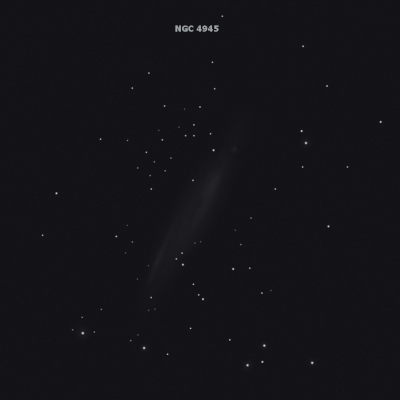
10x30mm Canon IS (3/28/19 - Tasmania): faint, large, very elongated glow. Required a careful look to see off and on, but easy to identify as situated just 18' E of mag 4.8 Xi 1 Centauri.
James Dunlop discovered NGC 4945 = D 411 = h3459 on 29 Apr 1826. This is one of the first objects observed by Dunlop (2nd night in logbook) and the first galaxy he discovered, along with NGC 5128 the same night. His description reads, "a beautiful long nebula, about 10' long, and 2' broad, forming an angle with the meridian, about 30 [degrees] south preceding and north following; the brightest and broadest part is rather nearer the south preceding extremity than the centre, and it gradually diminishes in breadth and brightness towards the extremeties, but the breadth is much better defined than the length. A small star near the north, and a smaller star near the south extremity, but neither of them is involved in the nebula. I have strong suspicions that the nebula is resolvable into stars, with very slight compression towards the centre. I have no doubt but it is resolvable. I can see the stars, they are merely points. This is north following the first zeta Centauri." Dunlop made a total of 7 observations and made a sketch (Figure 17).
John Herschel observed the galaxy on 31 Mar 1835 and recorded "B; vL; vmE; vglbM. Length much more than a diameter of the field, or than 15'. Its light extends to a star 14th mag beyond the parallel of Brisbane 4299. Position of elongation 38.7°." He placed the galaxy 10' too far north.
300/350mm - 12" (6/29/02 - Bargo, Australia): this long edge-on spiral is fairly bright and broadly concentrated with a slightly bulging core, extending SW-NE ~14'x2.5'. The surface brightness is relatively uniform with a weak central brightening and dimming towards the tips. Set in a rich star field peppered with faint stars. Located just north of a line connecting mag 4.8 Xi 1 Centauri 18' ESE and mag 4.3 Xi 2 31' SE. NGC 4976 is situated 30' E. Member of the Centaurus Group that includes both M83 and NGC 5128 and reddened by dust within our galaxy. NGC 4945 is comparable in dimensions to NGC 4565 although the dust lane was not evident.
600/800mm - 24" (4/11/08 - Magellan Observatory, Australia): remarkable spiral at 200x, extending southwest to northeast across 2/3 of the 30' field. I didn't take detailed notes on this observation but there was just a broad concentration with no well defined core region. The galaxy is very slightly wider through the center and only tapers towards the tips. Along the south edge, just southwest of center, is a brighter linear streak forming a sharp edge (the dust lane is just beyond). The main body of the galaxy fades a bit in this area and then brightens again further southwest. The major axis appears slightly warped or bent towards the north near the northeast tip, due to a large dust patch that bites a notch into the galaxy. On the south side of the northeast end, some very faint haze is visible. The DSS image reveals this is a portion of the galaxy beyond the dust lane. NGC 4945 is the second brightest member of the Centaurus A galaxy group and is situated 18' ENE of mag 4.8 Xi 1 Centauri.
Notes by Steve Gottlieb